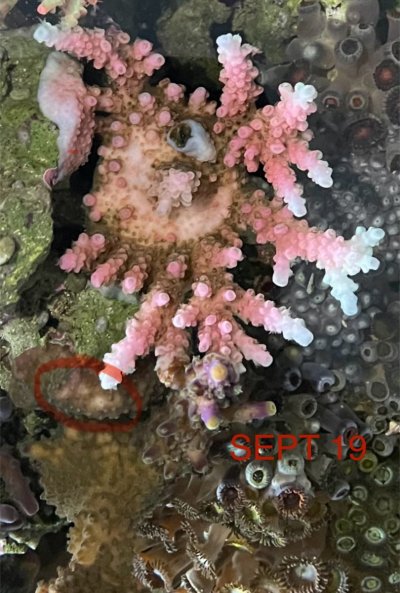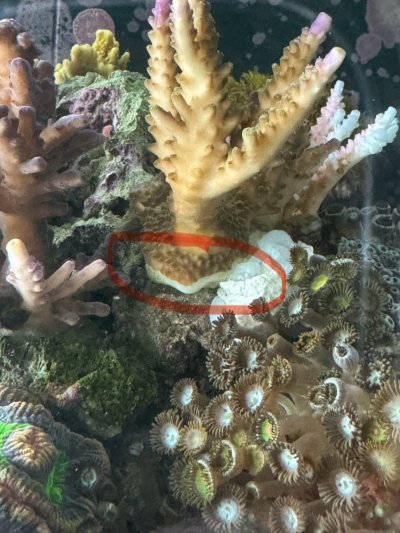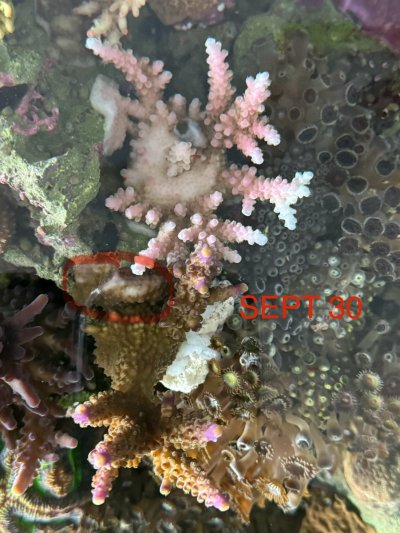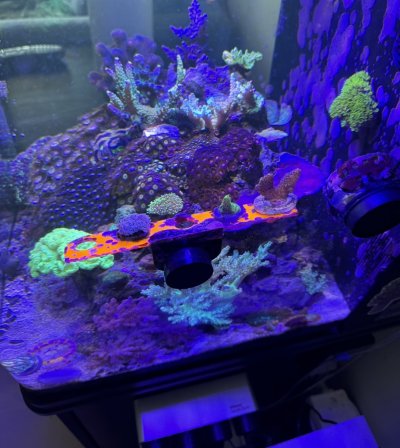Hello everyone,
Unfortunately dealing with one of my first “big” acropora issues since delving into keeping these finicky corals in my 32g Biocube.
All summer I had kept my alk between 7.4-7.8 and things had been taking OFF. Added a airstone Co2 scrubber in July as I had co2 issues in the morning with ph bottoming around 7.6. Ran this alongside my crappy Biocube protein skimmer than really hasn’t been running too efficiently lately. this brought pH into the 7.9-8.2 range. Anyways, growth had further taken off after this scrubber addition and things were fantastic. I was dosing All for Reef once per day, and as the alk demand kept creeping up, this became somewhat of a sizeable dose for my small tank. I went from around 3ml daily before the co2 scrubber to around 15mL daily over a couple weeks. Fantastic. For whatever reason I decide I want to run alk closer to 8.3 to give me more of a buffer. I run PO4 in the .06-.08 range and NO3 around 5-10PPM so thought this wouldn’t be an issue with a slow raise. WRONG. This is where my issues began. Alkalinity slowly rose from in the mid 7s (7.5-7.8) to the low 8s (8.0-8.2) over about a week and a half, and by mid September I was topping out at 8.5-8.6, which is the highest I was comfortable taking it. It took me until a month later after this change, to realize my Bill Murray colony wasn’t getting larger white tips from growth, it was actually a slow bleaching. Hmm, this was odd to me because I had a decent level of nutrients for this alk level, so what was happening? Well, I tested alkalinity every 24 hours. This appeared to be stable, BUT I failed to account for my massive AFR dose which spiked the alkalinity a few points after I dosed. This meant when I tested alk at 8.5 and dosed, it actually increased to around 8.8 to even 8.9 with a one time daily dose before dropping back down again 24 hours later. THIS was the heart of my issues began I believe, but not where the damage stopped.
September 19, I do my normal 10% water change and test the params about 30 mins after. Phosphate was .1PPM…just as I like it. I come home around 4PM, around 4 hours after the water change to a monti cap shedding skin, a closed stylo, and the bill murray had less polyp extension and was noticeably lighter. Somehow, PO4 had dropped from .1 to .03PPM, which has caused me HUGE issues with RTN in the past and this time was no exception. I dose Po4 back up to .1PPM and immediately the polyps on the stylo come back out, and the damage stops on the monti cap. I attribute the slow damage on the bill murray that was almost imperceptible for a period of time due to too many water changes leading to lower nutrients (nitrate also lowered to around 3PPM) at the higher alk level, so it was slowly starving. When the po4 rapidly dropped, since the colony is in high light and alk that potentially spiked to 8.8 after dosing, it took a substantial hit. It has reduced polyps during the day now, but does have more polyps out at night as well.
Now I am dosing both All for Reef and phosphate on a doser and this has kept things very stable for the last 5-6 days. Po4 remains .1 PPM which is what I am targeting, and I am very slowly dropping alkalinity back into the mid 7s. I’m taking it extremely slow and am running 7.9-8.0 right now. Yet things still are slowly getting worse it seems, although nothing is going downhill too rapidly.
Another of my best growers in high light started showing slow STN from the base a few days after the PO4 event, which makes sense. This acro was also growing into zoanthids, which I think exasperated the issue so I placed a rock between the zoanthids and the acro to avoid them touching anymore. You can also see lightening on the encrusting base of this acro on the areas receiving the highest light. This area has also gotten slightly larger between Sept 19 and today.
At this point, I am holding the line, feeding a lot, keeping parameters as stable as I can and hoping for a full recovery. Despite regaining stability for a week, things have still gotten slightly worse. I have removed activated carbon and turned off my skimmer since I am always running on the low end with nutrients, I don’t think I need the skimmer right now. Especially since I get better aeration from the air stone co2 scrubber. What else can I do to mitigate damage? The bleached colony cannot be moved to low light as it has been established for a while and has encrusted. I also have minor burnt tips on an oregon tort. All of my other acros in lower light been unaffected,
I am only seeing damage on the 300+ PAR areas.
MY BIGGEST QUESTION NOW - Should I lower my entire tank lighting intensity and risk putting everyone else in jeopardy? And if so, how much can I lower lighting at one time? Or is there a chance for recovery in its current place with stable parameters since this wasn’t lighting induced in the first place.
As always, thankful for any advice!



Unfortunately dealing with one of my first “big” acropora issues since delving into keeping these finicky corals in my 32g Biocube.
All summer I had kept my alk between 7.4-7.8 and things had been taking OFF. Added a airstone Co2 scrubber in July as I had co2 issues in the morning with ph bottoming around 7.6. Ran this alongside my crappy Biocube protein skimmer than really hasn’t been running too efficiently lately. this brought pH into the 7.9-8.2 range. Anyways, growth had further taken off after this scrubber addition and things were fantastic. I was dosing All for Reef once per day, and as the alk demand kept creeping up, this became somewhat of a sizeable dose for my small tank. I went from around 3ml daily before the co2 scrubber to around 15mL daily over a couple weeks. Fantastic. For whatever reason I decide I want to run alk closer to 8.3 to give me more of a buffer. I run PO4 in the .06-.08 range and NO3 around 5-10PPM so thought this wouldn’t be an issue with a slow raise. WRONG. This is where my issues began. Alkalinity slowly rose from in the mid 7s (7.5-7.8) to the low 8s (8.0-8.2) over about a week and a half, and by mid September I was topping out at 8.5-8.6, which is the highest I was comfortable taking it. It took me until a month later after this change, to realize my Bill Murray colony wasn’t getting larger white tips from growth, it was actually a slow bleaching. Hmm, this was odd to me because I had a decent level of nutrients for this alk level, so what was happening? Well, I tested alkalinity every 24 hours. This appeared to be stable, BUT I failed to account for my massive AFR dose which spiked the alkalinity a few points after I dosed. This meant when I tested alk at 8.5 and dosed, it actually increased to around 8.8 to even 8.9 with a one time daily dose before dropping back down again 24 hours later. THIS was the heart of my issues began I believe, but not where the damage stopped.
September 19, I do my normal 10% water change and test the params about 30 mins after. Phosphate was .1PPM…just as I like it. I come home around 4PM, around 4 hours after the water change to a monti cap shedding skin, a closed stylo, and the bill murray had less polyp extension and was noticeably lighter. Somehow, PO4 had dropped from .1 to .03PPM, which has caused me HUGE issues with RTN in the past and this time was no exception. I dose Po4 back up to .1PPM and immediately the polyps on the stylo come back out, and the damage stops on the monti cap. I attribute the slow damage on the bill murray that was almost imperceptible for a period of time due to too many water changes leading to lower nutrients (nitrate also lowered to around 3PPM) at the higher alk level, so it was slowly starving. When the po4 rapidly dropped, since the colony is in high light and alk that potentially spiked to 8.8 after dosing, it took a substantial hit. It has reduced polyps during the day now, but does have more polyps out at night as well.
Now I am dosing both All for Reef and phosphate on a doser and this has kept things very stable for the last 5-6 days. Po4 remains .1 PPM which is what I am targeting, and I am very slowly dropping alkalinity back into the mid 7s. I’m taking it extremely slow and am running 7.9-8.0 right now. Yet things still are slowly getting worse it seems, although nothing is going downhill too rapidly.
Another of my best growers in high light started showing slow STN from the base a few days after the PO4 event, which makes sense. This acro was also growing into zoanthids, which I think exasperated the issue so I placed a rock between the zoanthids and the acro to avoid them touching anymore. You can also see lightening on the encrusting base of this acro on the areas receiving the highest light. This area has also gotten slightly larger between Sept 19 and today.
At this point, I am holding the line, feeding a lot, keeping parameters as stable as I can and hoping for a full recovery. Despite regaining stability for a week, things have still gotten slightly worse. I have removed activated carbon and turned off my skimmer since I am always running on the low end with nutrients, I don’t think I need the skimmer right now. Especially since I get better aeration from the air stone co2 scrubber. What else can I do to mitigate damage? The bleached colony cannot be moved to low light as it has been established for a while and has encrusted. I also have minor burnt tips on an oregon tort. All of my other acros in lower light been unaffected,
I am only seeing damage on the 300+ PAR areas.
MY BIGGEST QUESTION NOW - Should I lower my entire tank lighting intensity and risk putting everyone else in jeopardy? And if so, how much can I lower lighting at one time? Or is there a chance for recovery in its current place with stable parameters since this wasn’t lighting induced in the first place.
As always, thankful for any advice!



Last edited:

















